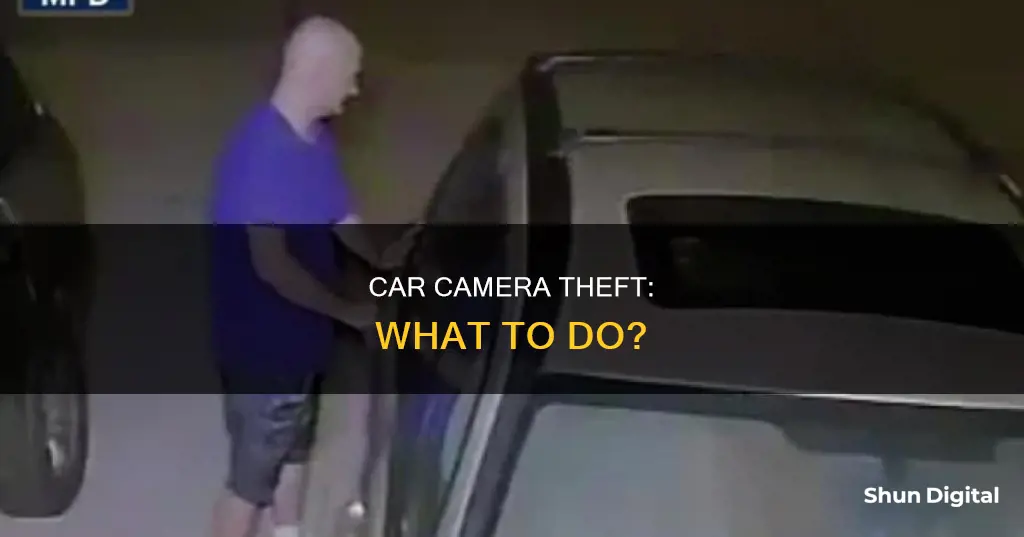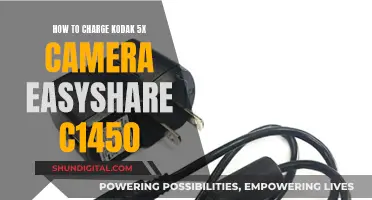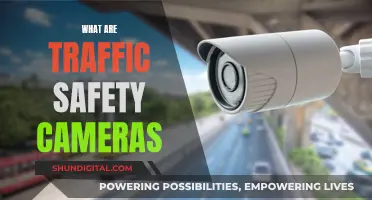
Dashcams are an effective way to improve security for your car, but they can also attract thieves. If a thief spots a dashcam, they may be tempted to steal it, along with any other valuables in the car. This is a common concern for those who want to install a dashcam, especially an expensive one. To prevent theft, dashcams can be hidden or placed discreetly, and some dashcams are designed with security in mind, such as the BlackVue DR770X Box Series, which has a separate unit for the processor, wifi source, and memory card, allowing the cameras to be smaller and less noticeable.
| Characteristics | Values |
|---|---|
| Effect on thieves | Thieves may be deterred by the presence of a camera, or they may break in and steal the camera to avoid being identified. |
| Camera placement | Cameras can be placed in various locations in the car, such as under the rearview mirror, on the dashboard, or in the glove compartment. |
| Camera size | Larger cameras are more noticeable, while smaller cameras are more discreet but may still be effective. |
| Camera shape | Tube-style cameras are less visible than bulkier models. |
| Camera features | Motion-sensing, parking mode, and cloud storage can enhance security and evidence collection. |
| Camera installation | Adhesive mounts, magnetic connections, and suction cups are common installation methods. |
| Cable management | Hiding cables can make the camera less noticeable and reduce the risk of theft. |
| Power source | Dash cams can be powered by the cigarette lighter or hardwired into the fuse box. |
| Additional security | In-car security devices like steering wheel locks and alarm systems can complement dash cams. |
What You'll Learn

Hiding dash cam cables
Using the Headliner
This method involves running the cable along the headliner, down the weather sealing or rubber stripping of the A-pillar, and then under the dashboard. You can choose to run the cable on the passenger side or driver side, ensuring it doesn't block your view. The cable can be tucked neatly behind the headliner, which can be gently pulled out to make room. This method may require the use of gum tape to secure the cable in some places, but be mindful not to block your view.
Hiding Behind Trims
This technique involves tucking the cable behind the trims of your car. Usually, following the path taken by the manufacturer for other wires is the best approach. For example, if your dash cam is installed at the top of the windshield, you can tuck the cable under the headliner, then behind the A-pillar trim, and down to the back of the dashboard. This method may require some loosening of the trims, so it is important to be cautious and seek professional help if needed.
Using Zip Ties or Clips
If you have issues with the cable popping out, zip ties can be a great solution. You can use large zip ties on the wire itself and then snip off the excess, leaving the cube-shaped part of the zip tie to hold the wire in place. Alternatively, you can use cable clips that may have come with your dash cam to keep the wire tight and in place.
Seeking Professional Help
If you don't feel comfortable hiding the dash cam cables yourself, you can always seek the help of professionals. Your local independent garage, auto electricians, car security experts, or sound specialists will have experience hiding wires and dealing with vehicle interiors. They can ensure a neat and safe installation for a small fee.
Shipping Camera Batteries: USPS Guidelines and Tips
You may want to see also

Hardwiring dash cams
Hardwiring a dashcam is a great way to ensure that your camera is always on and ready to record, providing valuable evidence in case of any incidents on the road. It also eliminates the need for a separate power source, reducing wire clutter and freeing up ports for charging other devices.
Step 1: Gather the Right Tools and Prepare
First, you'll need to purchase a hardwiring kit, which typically includes a fuse tap, a ground wire, and a power wire. Make sure the kit is compatible with your camera model and vehicle make and model. You'll also need tools like a circuit tester, wire cutters, and zip ties. Before you begin, carefully read the instructions and make sure you understand the process. If you're not comfortable working with electrical systems, it's best to seek professional help.
Step 2: Locate the Fuse Box
The fuse box is usually located under the dashboard on the driver's side. You may need to remove some panels or lift a cover to access it. Refer to your vehicle's user manual to identify the correct fuse box and fuse.
Step 3: Choose a Fuse Slot
Not all fuse slots are equal. Some control critical functions like airbags and stability control, so avoid those! Fuse slots for the radio, cigarette lighter, or sunroof are usually a safer choice. Use your circuit tester to identify a "hot in start" fuse, which only has power when the vehicle is running. You'll also need a constant fuse that provides power when the vehicle is off for parking mode recording.
Step 4: Connect the Hardwiring Kit
Now, it's time to connect the wires. The red wire typically goes to the constant fuse, the yellow to the "hot in start" or ignition-switched fuse, and the C-shaped wire is the ground wire. However, some kits may vary, so follow the labels on the cables. Use add-a-fuses and fuse-taps for a more secure and professional-looking installation. Insert the fuse tap into the add-a-fuse kit, ensuring the correct order, and then crimp the connection.
Step 5: Ground the Wire
Find a suitable grounding point in your car, such as a metal bolt or screw. Strip the end of the ground wire and wrap it around the grounding point, then tighten it to secure the connection.
Step 6: Test and Tidy Up
Once all the wires are connected, plug the kit into your dashcam and start your vehicle to test the camera. If it powers on, you've successfully hardwired your dashcam! Now, carefully tuck away any loose cables and use zip ties and electrical tape to secure and neaten the installation.
Common Mistakes
If it's your first time hardwiring a dashcam, be aware of some common mistakes. Ensure the correct orientation of the accessory and ignition-switched wires to avoid abnormal behaviour and battery drain. Check for a good ground connection, as a loose or weak ground may cause the camera to restart when the vehicle hits a bump. Also, ensure the correct setup of the add-a-fuse to prevent power issues.
Hardwiring your dashcam may seem daunting at first, but with the right tools, knowledge, and careful installation, you can enjoy the benefits of a tidy, reliable, and always-on dashcam system.
Easy Steps to Play Back Your Car Camera Footage
You may want to see also

Anti-theft dash cams
Dash cams are an effective way to protect your car from theft and keep yourself safe from any unwanted guests. While they may not be able to prevent theft, they can help capture footage of the culprits and keep a record of anyone causing damage to your car. This can be used as evidence to hold them accountable for their actions.
There are several anti-theft dash cams available on the market that offer advanced features such as motion sensing, parking mode, and cloud storage. These features allow the camera to detect movement near your vehicle and record for a pre-set period of time. They can also automatically turn on when an impact is detected, capturing video evidence even if your car is bumped or a window is smashed.
One example of an advanced anti-theft dash cam is the Owlcam. It offers AI surveillance protection and video recording even when the vehicle is parked and turned off. In the event of a break-in, Owlcam sends a real-time video alert to your phone and instantly stores all the video evidence in the cloud, even if the camera is stolen.
Another option is the Cobra SC series, which offers motion sensing and parking mode. The motion-sensing feature detects movement near your vehicle and records for a pre-set period, capturing any activities within the camera's range. The parking mode automatically turns on when the G-sensor detects an impact, capturing video evidence.
The AUTOWOEL 4K Dash Cam is another excellent choice for an anti-theft dash cam. It features dual-camera support for front and rear coverage, with the front camera offering 4K video resolution and the rear camera capturing 1080P resolution. The G-sensor allows the camera to capture emergency recordings when your car is parked, keeping your belongings safe.
The Vantrue N4 is a unique all-in-one camera setup with a three-channel dash cam, including front, inside, and rear cameras. It captures high-quality footage with a front camera at 4K resolution and the other two at 1080P resolution. The inside camera is ideal for rideshare drivers, and the setup features a Sony STARVIS CMOS sensor for improved exposure in low-light conditions.
Lastly, the VIOFO A129 Pro Duo is a durable and heat-resistant dash cam with a front and rear setup, offering 4K and 1080P resolution, respectively. It has an advanced parking mode that automatically starts recordings upon impact, and its dual-band Wi-Fi enables fast file transfers to your smartphone.
While these anti-theft dash cams provide excellent security features, it's important to note that they may also attract high-profile thieves due to their expense. Additionally, always remember to keep valuables out of sight and consider combining your dash cam with other anti-theft measures for maximum protection.
Simplisafe Camera Charging: How to Know?
You may want to see also

Car security devices
Car theft is a common occurrence, and it's important to take measures to protect your vehicle. Here are some car security devices to consider:
Dash Cams
Dash cams are a great way to deter thieves and capture evidence in the event of a break-in. Look for dash cams that are simple and screenless, making them less noticeable to potential thieves. Some dash cams, like the BlackVue DR770X Box Series, are designed with security and discretion in mind, allowing you to keep the recording unit out of sight. This makes it more difficult for thieves to access or steal the camera.
Steering Wheel Locks
Steering wheel locks are a simple yet effective way to prevent thieves from driving away with your vehicle. These locks attach to your steering wheel and extend out, preventing the wheel from turning fully. Examples include The Club 3000 and the Tevlaphee Universal Steering Wheel Brake Lock.
Wheel Locks and Clamps
Wheel locks and clamps, such as the Rimgard Wheel Lock and the TURNART Wheel Lock Clamp, prevent your wheels from turning or being removed. They act as a visible deterrent and make it difficult for thieves to move your vehicle.
Electronic Immobilizers
Electronic immobilizers are high-tech devices that prevent your car from starting unless certain conditions are met. Aftermarket options include battery-disconnect switches and ignition-kill switches. These devices require expert installation but offer an effective way to secure your vehicle.
Faraday Bags
Faraday bags, like the Ticonn Faraday Bag, are designed to block electromagnetic waves and signals. By placing your key fob inside the bag when not in use, you can prevent thieves from using relay attacks to boost and steal your key fob's signal, making it harder for them to unlock and start your car.
Digital Car Keys
If you tend to forget to lock your vehicle, a digital car key can be a helpful solution. These remote-locking apps, such as MoboKey, automatically lock your car when you move out of range, adding an extra layer of security.
It's important to note that while these devices can deter thieves and provide additional security, a dedicated burglar may still be able to bypass them. Combining multiple security devices can help improve your car's protection and make it a less attractive target for theft.
Finding Adobe Camera Raw Files: Location and Access
You may want to see also

Parking in secure locations
- Choose a discreet installation: Opt for a stealthy dashcam system that is less likely to attract attention. Look for wedge-shaped or barrel-shaped cameras that can be mounted discreetly against the windscreen using a sticky pad. Try to hide most of the camera behind dots or sensors, so only the lens is visible.
- Install in a less visible location: Consider installing the dashcam in a location that is not directly on the windscreen. For example, you could mount it to the side of a sensor array or in a dotted area on the windscreen in front of the mirror. This will make it less noticeable to potential thieves.
- Use a small camera: Size does matter when it comes to dashcam theft. Smaller cameras are less conspicuous and can be installed in tighter spaces, making them more difficult to spot.
- Hide the recording unit: Some dashcam systems, like the BlackVue DR770X Box, separate the cameras from the recording unit. This allows you to keep the unit out of sight, such as in the glove compartment, while the cameras remain discreetly mounted on the windshield.
- Utilize advanced parking modes: Look for dashcams with advanced parking modes that offer features like loop recording, intelligent parking mode, impact and motion detection, and time-lapse recording. These modes can help monitor your car even when you're not around.
- Consider removable options: If you're concerned about theft, opt for a dashcam that is easily removable. This way, you can take it with you when you park in less secure locations.
- Use a cheap alternative: Instead of investing in an expensive dashcam, consider buying a cheaper alternative. That way, if it gets stolen, the financial loss is less significant.
- Reserve parking in secure locations: When parking for extended periods, consider using services like SpotHero to reserve parking spots in secure locations. This ensures your car is parked in a monitored area, reducing the risk of theft.
- Utilize valet parking: When available, consider using valet parking services. This way, your car is parked in a secure area designated for valet parking, often with additional security measures in place.
By following these tips and parking in secure locations, you can significantly reduce the risk of camera theft from your vehicle. Remember to research and compare different dashcam models to find one that best suits your security needs and budget.
Kodak Camera Battery: How to Spot a Bad One
You may want to see also
Frequently asked questions
To prevent your car camera from being stolen, you can hide it in a discreet location, such as behind a dotted area on the windscreen or under the glove compartment. You can also use a dual-remote system, where the small camera units are mounted on the windscreen while the main unit is hidden elsewhere in the car. Additionally, you can turn off any flashy lights on the camera to make it less noticeable.
If your car camera is stolen, you can contact the police and provide them with any relevant information, such as the make and model of the camera, as well as the date and location of the theft. You may also want to consider installing a new camera with additional security features, such as motion sensing and parking mode, to deter future theft.
The consequences of having your car camera stolen can vary. You may lose the ability to record incidents while driving, which can provide valuable evidence in the event of an accident or incident. Additionally, you may incur financial losses, as car cameras can be expensive, and you may need to purchase a new one.







